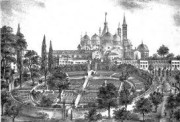Primitive Houses in Italy
In the Primeval times the first men didn’t have a real house, but more a shelter . They were used to spend all their time outdoors and to seek shelters under rocks or trees during the night. In the next phase they started to built some kinds of canopies made of branches and grassy foliages intertwined. These men were beginning to conceive a permanent repair, and not much time passed since they became the caves’ inhabitants ( troglodytes : cave’s inhabitants ). In the caves they formed the first Paleolithic communities where everything was shared, women included. This was a life in groups, but it wasn’t intended to last long. Man was beginning to desire his own personal group: his family. This epochal transition, studied by ethnologists and anthropologists, started a real new organization that put the family at the center around which every man life’s moment started to turn. The space was not in communal anymore, but they became very personal. This new family’s environment was the first prototype of the modern house. The Neolithic man had so his personal family with his personal woman. The caves became single-family houses, more comfortable and decorated with the first artistic expressions: the paintings on the cave’s walls ( graffiti ). These caves even benefited from a good ventilation thank to various openings through which the air flowed , permitting to maintain a fresh climate also during the hot summers . In the Stone Age Man started to work leather and the wood with the sharp stones and built his first huts, with circular outline, made with wood crossed poles and leather infillings. The huts villages in the Bronze Age, where men practised agriculture, have subsequently evolved in some alluvial zones as Lombardy, Emilia and Veneto, under the form of pileworks villages. The pileworks were, practically, huts, built upon artificial platforms and embankments protected by banks or ditches.





